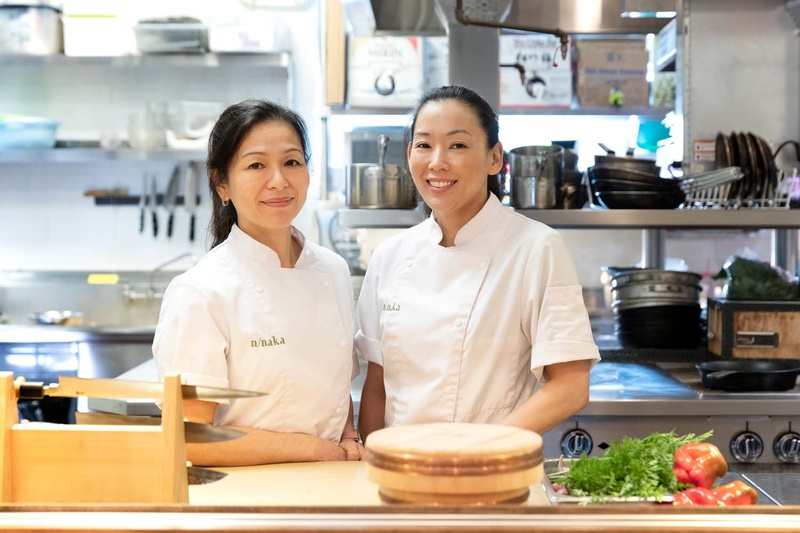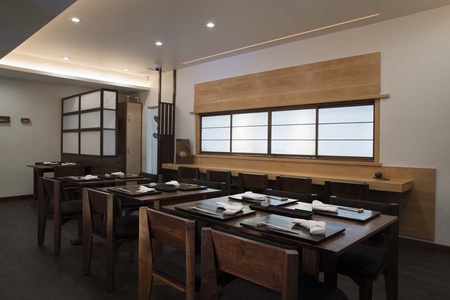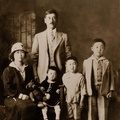Niki Nakayama, who heads n/naka restaurant in Los Angeles, is the most famous kaiseki chef in America. You can watch her on 2015’s season one of Chef’s Table, surgically cutting open a prickly-skinned sea urchin with gloved hands and a big pair of scissors, then layering its mustard-colored lobes with ikura fish roe and garnishing it with a small, delicate square of edible gold foil and a red-veined sorrel leaf. Or you can read about her in the Michelin Guide to Los Angeles, which awarded her two stars in 2019.
Based on the love that critics have lavished on her, you might not guess that Nakayama was once a typical Japanese American teen growing up in Southern California eating tacos, spaghetti, and her favorite dish, steak with A-1 sauce. It seems fitting that Nakayama and her partner in business and in life, Carole Iida-Nakayama, celebrated their two-star ascension with a taco truck party for their staff.
Koreatown, where she was born, and Monterey Park, where her family lived during her teenage years, are just a short drive from n/naka, her globally lauded modern Kaiseki restaurant on Overland Avenue in Palms. Yet for Nakayama, the psychic and spiritual journey from San Gabriel Valley to the Westside was an immeasurably long one.
Along the way there have been battles: for respect as a woman in the kitchen; for belief in her from a family that valorized men and believed women should be supporting players; from a public that found it hard to believe that a beautiful and diminutive woman wielding a sashimi knife should be taken seriously as a cook.
Yet as the mature master chef that she is today, Nakayama looks back at some of the more difficult experiences of her life and realizes that she was learning and growing all along. That family that for a long time did not understand her also runs a seafood company, Unified Seafood Co., in and around which she grew up. “They put me in so many different positions I did not enjoy. I didn’t want to sell, I didn’t want to smell like fish every day—though that didn’t pan out as I hoped,” she says dryly. Now, she understands how valuable it is to have “an innate understanding of what good quality seafood is, and how to respect it. I didn’t realize it back then, but I understand now how important that was to my education.”
She can also appreciate how fortunate she is to be Japanese American. “The best part of growing up in two cultures is that you get to choose what you feel is most true to who you are, taking the best of Japanese culture, the things that resonate, and the best of American culture, combining both, versus leaning one way or the other,” Nakayama says. “I would never want to sacrifice growing up in America, just as I would never want to sacrifice the wonderful things about Japanese culture.”
But the most fortunate occurrence in her life she would tell you, is finding her partner in the kitchen and in life, Carole Iida-Nakayama. The two women’s backgrounds were strikingly similar. Both were daughters of Japanese immigrants, and both families ran food businesses. Iida’s parents operated a sushi shop, and for a time Iida operated a rice bowl-focused restaurant, Haiku Kitchen, in Pasadena.
They began dating in the summer of 2012. Two months later Nakayama suddenly lost her sous chef, and was desperate for help. Iida was the obvious emergency fill-in, but Nakayama says, “I was very hesitant and nervous about us working together, I worried it would be too much. Luckily we worked well together.” Iida has been by her side in the kitchen ever since.
In the kitchen, Nakayama says, “Carole feels I’m the more creative one but my ideas can be really big and almost impossible to execute. Carole helps me tone it down, figure out ways to make it happen. She has the ability to see it through to the next level—not just focus the idea a lot more, but to add another layer of depth to the creative process. That’s always been our strength.”
The two were married in 2015, and Nakayama says, “I feel that sometimes the universe has a plan and when we’re open to those plans things seem to work out better. Not that we don’t want to kill each other sometimes, but at the end of the day, it’s important that the person that you have working next to you cares about the work as much as you do.”
After graduating from the Institute of Culinary Education in Pasadena in 1997, Nakayama worked for a short time at Takao restaurant in Brentwood, where chef Takao Izumida was elevating his sushi menu with luxury ingredients like truffles and caviar. Later that year she headed to Japan for a seminal three-year apprenticeship in Japanese cooking, working in the kitchen at Shirakawa-ya, the ryokan of a distant relative in Tokamachi, Niigata Prefecture.
Back in Los Angeles, at the urging of her family, she opened the sushi restaurant Azami Sushi Café on Melrose Avenue. Though she made it a success, after eight years she felt burnt out and frustrated at the limitations of sushi. She wanted a broader creative canvas. n/naka, which she launched in 2011, was the answer to that itch.
Kaiseki cuisine showcases seasonal ingredients at their peak; the challenge for the chef is to coax out their essence with minimal manipulation. Servers at n/naka make clear to customers that what they are about to experience is California kaiseki cuisine, and the chef looks to local sources for as many ingredients as possible.
One dish you might see on the menu, for example, features local California vermillion rock fish, rarely seen on Japanese menus. Where in the past the chef might have prepared it in a traditional style of yuanzuke (marinated in a mixture of soy sauce, sake mirin, and yuzu juice), Nakayama channels season and place to create something new. She uses the familiar arima-yaki style of marinading it in sansho pepper, but finishes the dish with rabbit tobacco, a local herb sourced by a forager she works with. “It’s very unique, a little like the essences of cumin and curry,” Nakayama says. “We grill the fish over bincho charcoal, Japanese style, then smoke it with the rabbit tobacco. It’s a flavor profile not found in Japanese cuisine.”
It is preparations like this one, she adds, that “really define a sense of place and a sense of the environment. Taking non-Japanese ingredients and using very Japanese techniques on them is a wonderful way of discovering and crossing cultures.”
Other signature dishes include spaghettini with abalone, pickled cod roe, and truffles or a kanpachi sashimi served with avocado sauce and bell pepper and jalapeño jellies. Nakayama works with a local Japanese seafood monger who uses the ikejime method of fish slaughter and is able to identify and supply her with fish she can use for her sashimi courses.
Nakayama’s genius is her intuitive ability to orchestrate Japanese techniques and Southern California ingredients into something completely new and all her own. But she knows that the kitchen skills that have allowed her to reach this level of mastery are in large part the result of her grueling apprenticeship in Japan. Gaining those skills was another battle she fought with quiet determination, and she is both critical and appreciative of the traditional Japanese culinary apprenticeship. “Japan hasn’t always been very kind to women trying to acquire a traditional skill set that is not considered feminine,” she acknowledges.
The appreciation surfaces when I ask how Nakayama negotiated the male-dominated bro culture of restaurants. She answers the question by returning to Japanese culinary education. “The way Japanese culinary chefs teach their craft feels very limiting on some levels. But it’s also humbling, and that’s one thing Japanese chefs want to impart—a level of humility. I make fun of the whole Karate Kid ’wax on, wax off,’ thing.” But in addition to stressing rote repetition and observing over teaching, the Japanese chef’s attitude she adds, is, “‘You need to prove your dedication and love of learning before I teach you what I’ve worked so hard to learn.’”
Instead of adopting the western attitude of entitlement, “I’m the student and your job is to teach me all the things I need to know,” Nakayama tried to be the kind of ideal Japanese apprentice who “has the heart to take the time to learn on their own, to educate themselves, with care, and love, and to impart that feeling to guests.” She came away from her Japanese education determined “to pick what I really enjoy and respect and find a way that makes sense to me.” One of those positive lessons was employing the traditional Japanese concept of omotenashi, or warm hospitality.
These cultural differences also inform her conflicted attitude toward ratings like the Michelin star system. When she opened n/naka, she admits, “part of me hoped to achieve three stars one day, knowing that LA didn’t have a Michelin guide. It was just an aspiration, something to strive for. Of course any type of success always comes with additional pressure, but I always felt it was fuel to keep improving, and trying to do better.” But she adds, “It can be disheartening” to be part of a world of “best of lists,” especially when chasing those symbols of approbation become “so much more important to people than doing the work.” She adds, “I’m not discounting chefs who feel these things are important to achieve, but it’s something that’s completely the opposite of who I am.”
The pressure to be on social media, too, feels like a burden to her. “It doesn’t feel genuine to who I am, it feels like a game, and I don’t like those games. I’m not good at it, I’m weird in social situations—on some level it can be too much.” While she knows she would be thrilled to one day be awarded three Michelin stars, she adds, “I wish I could be that person that doesn’t care. I just want to do this work because I really love the craft of cooking and I love the creative process.”
At one time a serious musician who played piano and guitar and sang in her high school choir, Nakayama idolized the Japanese pop star Akina Nakamori and dreamed of a career in music “until I realized how unrealistic it was.” As a chef, she sees many parallels between music and cooking. “Every time I put out a different menu it’s like coming out with a whole new album,” she says, though she adds that “cooking feels so much more tangible,” an easier mode of communication. Cooking, she says, “is an expression of love, and care. To be able to give that to our guests has always been one of the biggest motivating factors of what I do.”
At the moment, Nakayama and Iida-Nakayama are considered part of a rising wave of Japanese American cuisine that is sweeping Los Angeles. Although it has been dubbed “Nikkei cuisine,” I prefer “Japanese American cuisine” to differentiate it from South American Nikkei cuisine. Last year, the couple launched a bento box pop-up, and in April opened n/soto, a casual izakaya on Washington Boulevard in Mid City Los Angeles.
Nakayama does like serving the Nikkei community “because people can understand all the nuances” that she herself grew up with and is channeling, “They can see how that blend happens and appreciate it, while westerners might just think this is Japanese cuisine.”
For the foreseeable future Nakayama says, “I see myself continuously working to reach some level of mastery at my craft. The list of what I want to learn is way longer than the things I know how to do.” Her comment is an expression of pure Japanese shokunin spirit, as are her next words: “Every time I start a new season, I feel like I’m starting from zero, newly learning how to do this work.”
(All photos are courtesy of Niki Nakayama)
* * * * *
Combining Culinary Cultures: A Conversation with Nikkei Chefs from Los Angeles, São Paulo, and Lima
Saturday, December 3, 2022 • 3 p.m. (PST)
Join us for a conversation with noted Nikkei chefs—Niki Nakayama of n/naka (Los Angeles, CA, US), Telma Shiraishi of Restaurante Aizomê (São Paulo, Brazil), and Roger Arakaki of Sushi Ito (Lima, Peru).
REGISTER NOW!:
5dn.org/nikkei-chefs
*This program will be presented via Zoom with simultaneous translation in English, Spanish, and Portuguese. Registration is required. Space is limited, so register now!
© 2022 Nancy Matsumoto












